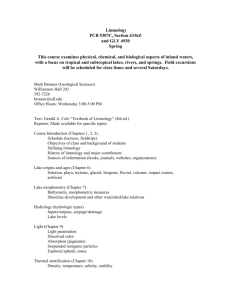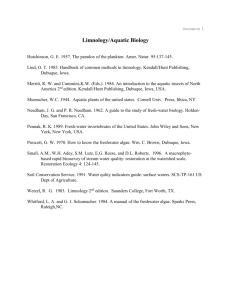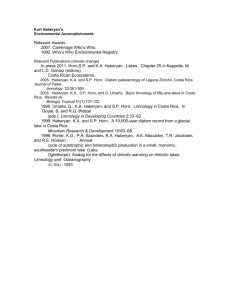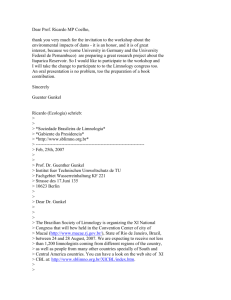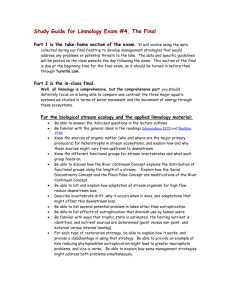Feb 9 | Aquatic Ecosystems
advertisement
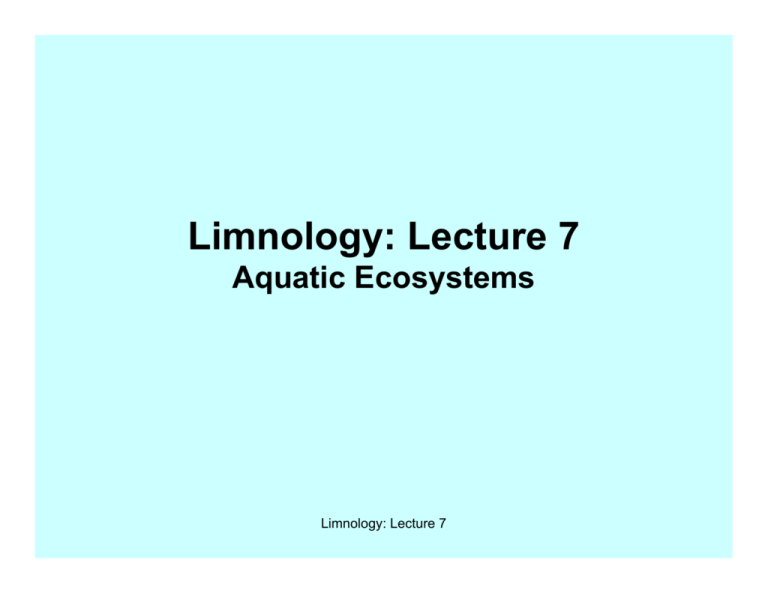
Limnology: Lecture 7 Aquatic Ecosystems Limnology: Lecture 7 I. Ecosystem Ecology • General discussion of specialties of ecology, origin of the ecosystem perspective, and its emphasis on biology, geology, and chemistry, close history with limnology A. Structure and Function: 1. Structure: pools, storage, box (mass/area) 2. Function: arrow, process, rate (m/time) B. Energy (E) Flow & Nutrient Cycling: 1. E-flow as a measure of the functioning = metabolism = OM dynamics 2. Nutrient cycling = transformation and relocation of elements C. Ecosystem perspectives and limnology: 1. Early studies of lakes viewed them as "microcosms", e.g. Forbes (1887) viewed the lake as an interactive system with boundaries 2. Functional approach take by Lindeman (1942), quantified producers and consumers, used Eflow to measure Limnology: Lecture 7 Lindeman 1942 II. Lake Structure • A. B. C. D. Structural divisions of lakes, not always functional units, more related to the distribution and characteristics of biota photic and aphotic zones: depth of lake including >1% of incident light = photic zone, the zone with <1% of incident light is the aphotic zone littoral zone: areas where the shore is in the photic zone: Wetzel's littoral zonation: The Zone of Macrophyte Growth on the Shore of a Lake (See Figure 7-1) 1. Epilittoral - above the high water level and uninfluenced by spray 2. Supralittoral - above the high water level and subject to spray 3. Eulittoral - the shoreline region between the highest and lowest seasonal water levels 4. Eulittoral plus infralittoral = littoral zone 5. Infralittoral a. Upper infralittoral - zone where emergent rooted macrophytes exist b. Middle infralittoral - zone where floating leaved macrophytes exist c. Lower infralittoral - zone where rooted or adnate macrophytes exist d. Littoriprofundal - zone where only photosynthetic algae and bacteria exist (often associated with the metalimnion) profundal zone - lake bottom w < 1% light, where sediments are free of vegetation pelagic zone, open-water not impacted by shoreline and/or littoral biota or processes Limnology: Lecture 7 III. Lake Habitats A. B. C. D. E. Planktonic - free-floating 1. Phytoplankton - free-floating algae 2. Zooplankton - free-floating animals with limited powers of locomotion 3. Tychoplankton - Suspended benthic organisms (not true plankton) 4. Metaphyton - Phytoplankton existing within the macrophyte communities of littoral zones Nekton - free-swimming 1. Some organisms (such as larvae of fish) can shift between planktonic to nektonic existence within their life cycle Pleuston - organisms adapted to the habitat of the air-water interface Neuston - the microscopic component of the pleuston 1. Epineuston or epipleuston are those forms that exist on top of the water's surface 2. Hyponeuston or hypopleuston are those forms that exist under the water's surface but still associated with the air-water interface Benthos - organisms that live on the bottom of a lake, stream, or river (See Figure 7.2) 1. Benthic is the adjective that is used to describe organisms that live on the bottom 2. The film of algae, bacteria, fungi, and invertebrates that exist on substrates is known as periphyton a. Periphyton literally refers to organisms living "on plants" but is most often used in the more general sense b. The term Aufwuchs is sometimes used for the film of algae, bacteria, fungi, and invertebrates that exist on substrates, Aufwuchs is a term derived from the German for "growth upon“ c. There is a recent trend to describe these periphyton communities more exactly i. Epilithic - living on rock substrates ii. Epipelic - living on fine organic sediments iii. Epiphytic - living on plants iv. Epizooic - living on animals v. Epipsammic - living on sand grains Limnology: Lecture 7 Limnology: Lecture 7 IV. Standing Crops A. B. C. Standing crop: - weight of organic matter that can be sampled or harvested at one time from a given area (not necessarily the whole plant), called standing stock if calculated for animals 1. Dry weight - dried in oven at 60°C for at least 24 hours 2. Ash-free dry weight - weight of ash (determined by weighing the residue after burning sample in furnace at 550°C for at least 4 hours) is subtracted from the dry weight to determine ash-free dry weight = Biomass - the weight of all living matter in a unit area at a given time (includes the whole plant) 3. Estimation of abundance of organisms a. Enumeration, b. Volume c. Weight 4. Nutrient pools - Cellular constituents - calculated as percentage of standing stock (e.g. carbon = 40-60% for most plants, nitrogen = phosphorus) Allochthonous organic matter - organic matter that is derived from outside the system (in lakes and streams, this is usually leaves, needles, wood, and twigs from terrestrial vegetation) Autochthonous organic matter - organic matter-derived within the system (in lakes and streams, this is usually algae, mosses, and aquatic vascular macrophytes) Limnology: Lecture 7 V. ECOSYSTEM METABOLISM A. B. C. D. Primary Production (PP): rate of fixation of inorganic carbon (i.e. CO2) as newly formed organic carbon - defined as autotrophy, in lakes = plants of littoral zone, periphyton & phytoplankton, formula shows PP = CO2 sink and O2 source, arrow or process Respiration (R): the rate of destruction of pre-formed organic matter (i.e. biological oxidation) - all heterotrophs do this, any biological oxidation contributes to decomposition, but often specific types of organisms are associated with detrital consumption = detritivores or decomposers, R = sink for O2 source of CO2 Net Primary Productivity: NPP or PN = amount of new carbon formed after total amount of fixation is corrected for system respiration; contrasts with GPP or Gross Primary Productivity (PG) defined as total amount of energy fixed as carbon during primary productivity, it follows that PN = PG – R Fates of PN: what happens to produced organic matter of plants? 1. Can contribute to growth (change in biomass over time), may include reproductive tissue = yield 2. Can add to detrital pool via non-predatory mortality (NPM) = litter fall or other 3. May be consumed by predation or grazing Limnology: Lecture 7 VI. MEASURES OF PN, PG AND R IN LAKES AND STREAMS • In lakes, the form of the lake will determine the distribution of productivity (i.e. among littoral, benthic, pelagic environments). In rivers, a vast majority of productivity is often benthic. With these assays, one can measure the change in gases (O2/CO2) over time to derive rates of photosynthesis and respiration A. light-dark bottles: captured portion of the water column is representative of all the lake 1. light bottle processes: PG of primary producers & R of all biota 2. dark bottle processes: R of all biota 3. combined measure (light-dark): PN of encapsulated system B. benthic chambers: enclosed portions of the benthos with all biota, circulating water to mimic stream conditions, dark cloth to mimic night; light - dark to derive estimate of PN Limnology: Lecture 7 VII. ENERGETIC PROPERTIES OF ECOSYSTEMS A. Autotrophic - gross primary production within the system exceeds respiration. This is often expressed as the ratio of production to respiration (PG /R). The P/R ratio of autotrophic systems is equal to or greater than one B. Heterotrophic - respiration within the system exceeds gross primary production. The P/R ratio is less than one in heterotrophic systems C. Residence Time: (B/P): biomass/production = time, amount of time the average particle of OM spends in the subsystem with biomass (B) and productivity (P) D. Turnover Ratio: Production to biomass ratio (P/B) = t-1, the fraction of the pool that "turns over" during a period of time, essentially a "half-life", also a measure of the metabolic intensity or activity. 1. High P/B ratio with smaller organisms 2. P/B generally decreases with increases in size and increasing trophic level. 3. Lower P/B in oligotrophic than eutrophic. Limnology: Lecture 7
